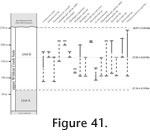|
|
|
BIOSTRATIGRAPHY AND BIOCHRONOLOGYThe Milk Creek tuff produced one fossil, a rhinocerotoid or hyracodontid tooth. The size of the tooth compares to rhinocerotids and hyracodontids younger than middle Chadronian, about 34 Ma. A zircon fission track age of 33.7 Ma supports the correlation and places this specimen as the oldest non-marine mammal collected in Washington (Vance et al. 1987).
Taxa indicative of this correlation are Cormocyon copei, Enhydrocyon, Parenhydrocyon josephi, cf. Palaeolagus, Miohippus equiceps, Diceratherium annectens, Hypertragulus, Eporeodon, Merycoides, Mesoreodon, and Promerycochoerus superbus. Many of these taxa are represented in early early Arikareean (Ar 1) and late early Arikareean (Ar 2) assemblages, though Enhydrocyon sp., ?Miohippus equinanus, Miohippus equiceps, Diceratherium sp., Hypertragulus, and Eporeodon sp. are also present in earlier, Whitneyan, deposits (Tedford et al. 2004; Albright et al. 2008). ?Miohippus equinanus does not extend to the Ar 2 in Oregon, but is known to persist through the Oligocene of the Great Plains (MacFadden 1998). Cormocyon copei, Parenhydrocyon josephi and Mesoreodon sp. first occur in the Ar 1 of Oregon and continue into the Ar 2 (Wang 1994; Stevens and Stevens 2007).
The medial Arikareean correlation for unit B of the upper Wildcat Creek beds is supported by Ar/Ar age analyses restricting the deposition from 27.16 ± 0.19 Ma to 26.97 ± 0.30 Ma (Table 7, Hammond, personal commun., 2006). This chronology refines prior assessments of the Wildcat Creek beds and suggests the later persistence of ?M. equinanus in the Pacific Northwest. |
|

